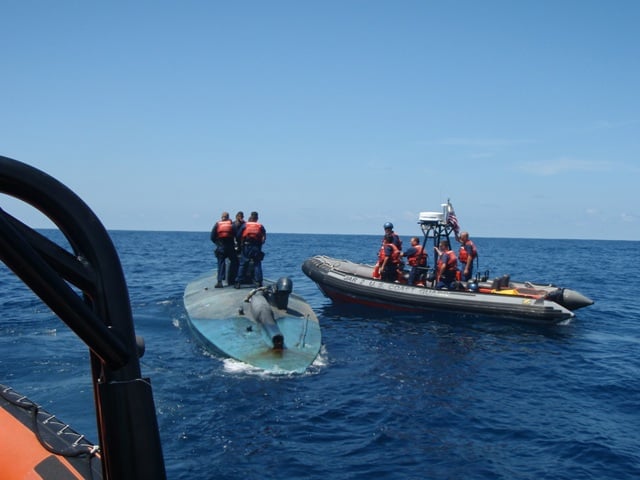
CORRECTION: A previous version of this post titled: ‘Coast Guard: Budget Cuts Led to 30 Percent Increase in U.S. Drug Traffic’ misstated the cuts to the service resulted in a 30 percent increase in drug traffic to the U.S. The Coast Guard’s operations for interdiction missions fell by 30 percent. It is unclear if there is a direct correlation.The post and the headline have been amended to clarify the distinction. Additionally, the annual number of narcotics produced in Latin America is 800 metric tons and 400 metric tons are consumed in the U.S., not 800 million and 400 million. USNI News regrets the error.
“The only place we could squeeze” to meet the $200-million bill the Coast Guard faced under sequestration “was drug interdiction and migrant interdiction,” the service’s outgoing commandant told a key oversight subcommittee on Tuesday. He estimated that because of those cutbacks there was a 30 percent drop in operations to interdict drugs from entering the United States last year.
Adm. Robert Papp, who is scheduled to retire May 30, said that 800 tons of narcotics are produced in Latin America, 400 metric tons are consumed in the United States and about 120 metric tons are intercepted off ships in transit zones bound for this country. “That’s where you pick up the big loads.” Most often the interdictions are done with its aging fleet of Medium Endurance Cutters.
“All the rest [of the nation’s counternarcotics efforts] captures 40 metric tons,” largely because once ashore the quantities are broken up into smaller units and then dispersed.
Narcotics interdiction “is a capability we have to keep” because drug trafficking has an impact “not just on our streets” — but also in Mexico and Central America, but it was an area that could be cut under the Budget Control Act of 2011.
Testifying before House Homeland Security’s Subcommittee on Border and Maritime Security, Papp said the cutters’ average age is 46. “It’s no longer possible to sustain these vessels,” he said, noting that three of them were pulled from service last year for emergency hull repairs.
Papp said that he was pleased that the Coast Guard’s request to build eight National Security Cutters to replace its fleet of High Endurance Cutters was on course—three having been delivered already, a fourth to be commissioned in October, with funds provided to build the next three and long-lead money approved for the eighth. But the Medium Endurance Cutters remain a challenge. “We can’t continue to run the old ships” and their replacements are needed as soon as possible. The question is, “what will [the service] need 10, 20, 30, 40 years from now?”
Subcommittee chair Rep. Candice Miller, (R-MI) noted in her opening statement that the average age of Coast Guard offshore vessels is 40 years while the Navy Fleet average is 14 years.
Papp said the Coast Guard’s 500-vessel fleet for close-in waters are “all practically brand-new,” but “that’s Red Zone defense”—not the “layered security” the service’s strategy calls for, from foreign ports through transit zones to the maritime exclusion zones on the Atlantic and Pacific coasts and American ports.
He added: “We are doing everything we can to prevent a Mumbai attack”—alluding to the Pakistan-based terrorists’ small-boat raid on the Indian city’s beaches. “You have to have good intelligence” to ward off such attacks and that is why it so important to include the Coast Guard in the intelligence community. He noted that the service screened and vetted 126,000 vessels and 30 million passengers before they entered the United States.
Papp acknowledged the sequestration’s impact in another way in answering a question about why the Coast Guard’s patrols in the air and on the water declined by more than 6,000 hours last year because of “asset failures,” in the words of a Department of Homeland Security inspector general’s report.
The passing of a budget for Fiscal Year 2014 will allow the Coast Guard to restore training hours and step up its ship maintenance work, including that for vessels operating on the Great Lakes. “Where I feel I am letting [Coast Guardsmen] down” is not being able to pay for the training to keep them proficient in their careers and being ready for a host of missions under sequestration, Papp said.
“We have restored the focus on proficiency and we have restored the focus on mission readiness” with the budget signed into law.
The spending limits in the past year prevented the Coast Guard from sending an icebreaker, when requested, to the Antarctic and also to pull out of exercises with the Navy. At the same time, the service was and is being asked to do more operations in the Arctic and likely will have to take on more icebreaking missions on the Great Lakes because of this severe winter, Papp said.
He said in his four years as commandant it has been “my job to be honest and candid” about the requirements, but “when I’m given a top line, then I make the tough choices.”
The administration’s budget request for Fiscal Year 2015 is scheduled to be delivered to Congress on March 4.





